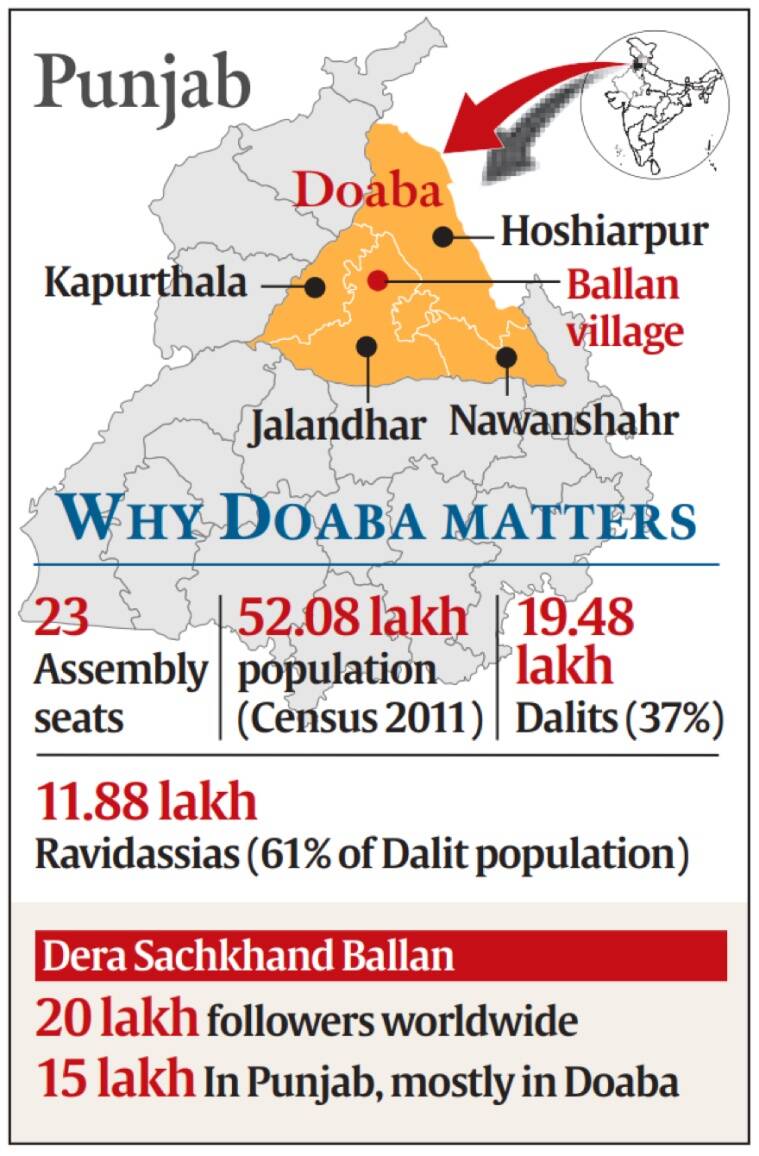Ravidassia
This is a collection of articles archived for the excellence of their content. Additional information may please be sent as messages to the Facebook community, Indpaedia.com. All information used will be gratefully acknowledged in your name.
This is a collection of articles archived for the excellence of their content. |
A backgrounder
Anju Agnihotri Chaba, January 18, 2022: The Indian Express

From: Anju Agnihotri Chaba, January 18, 2022: The Indian Express
Who are the Ravidassias?
The Ravidassias are a Dalit community of whom the bulk — nearly 12 lakh — live in the Doaba region. The Dera Sachkhand Ballan, their largest dera with 20 lakh followers worldwide, was founded in the early 20th century by Baba Sant Pipal Das. Once closely connected with Sikhism, the dera severed these decades-old ties in 2010, and announced they would follow the Ravidassia religion.
The dera made the announcement on Guru Ravidas Jayanti in Varanasi. Guru Ravidas was a mystic poet saint of the Bhakti Movement from the 15th and 16th centuries, and founded the Ravidassia religion. From 2010, the Dera Sachkhand Ballan started replacing the Guru Granth Sahib with its own Granth, Amritbani, carrying 200 hymns of Guru Ravidas, in Ravidassia temples and gurdwaras.
How was the Dera Sachkhand Ballan established?
Its founder, Baba Sant Pipal Das, was originally Harnam Das from Gill Patti village in Bathinda. When his wife died, he left home along with his son Sarwan Das. They reached Sarmastpur near Jalandhar, and then Ballan village, where they settled in 1895. Dera officials said Baba Pipal Das and his son started living under a dry pipal tree. As they watered it, it gradually bloomed, earning the Baba the name Sant Pipal Das. Dera members said he was well versed in Guru Granth Sahib bani, and began to win followers, including those who followed the teachings of Guru Ravidas. He went on to establish the Dera Ballan.
After the death of Sant Pipal Das, his son Sant Sarwan Das headed the dera from 1928 to 1972. There have been three more heads since, none chosen by heredity.
The third leader, Sant Hari Das, born at Garha village of Jalandhar, spent his entire life at Dera Ballan. The next dera head (1982-94), Sant Garib Das from Jalbhe village in Jalandhar, also spent his life at the dera, where he impressed Sant Sarwan Das. The current head, Sant Niranjan Das, born on January 5, 1942 at Ramdaspur village in Jalandhar, is the son of a couple who were devotees of Sant Pipal Das and who offered their son to Sant Sarwan Das, who gave him the name “Hawaigar” for the speed at which he performed his duties.
What is the significance of Guru Ravidas Jayanti?
During his tenure, Sant Sarwan Das undertook the work of establishing a memorial temple in Varanasi. After identifying the birthplace of Guru Ravidas at Seer Goverdhanpur village near Banaras Hindu University, the dera bought land there. The foundation stone for a temple was laid in 1965, and its first phase completed in 1970. NRI followers too contributed funds.
Several followers from Ballan started visiting the temple and, over time, it became a practice to observe Guru Ravidas Jayanti in Varanasi. Gradually, the dera in Ballan became the largest dera of the Ravidassias. Since 2000, the Dera Sachkhand Ballan has been taking followers on the Begampura Train from Jalandhar to Varanasi on Guru Ravidas Jayanti every year.
How significant is the dera politically?
Punjab has thousands of deras, small and big. Because of the numbers these command, political leaders having been visiting them for the last several elections. These include the Dera Sachkhand Ballan, where party leaders have visited and met its head.
The Dera Sachkhand Ballan has never openly supported any political party, but welcomed every visiting political leader. Visitors this time have included Punjab Chief Minister Charanjit Singh Channi (Congress), Delhi CM Arvind Kejriwal (AAP), Punjab Congress president Navjot Singh Sidhu, Akali Dal chief Sukhbir Badal, and senior BJP leaders.
Of the dera’s 20 lakh followers worldwide, around 15 lakh live in Punjab, mostly in the Doaba region that has 23 Assembly seats (out of Punjab’s 117). Around 32% of Punjab’s population comprises Dalits, whose concentration is highest in Doaba at 37% (19.48 lakh Dalits out of a regional population of 52.08 lakh). And 61% (11.88 lakh) of Doaba’s Dalits belong to the Ravidassia community. Doaba has hundreds of deras, besides Dera Sachkhand Ballan.
That explains representations made to the Election Commission by several political parties seeking a postponement of the elections on account of Guru Ravidas Jayanti. CM Channi, who had written to the ECI seeking postponement, is a Dalit Sikh from the Ramdassia community, and his elevation had lifted all Dalit groups including Ravidassias.
How assertive are the Ravidassias?
They have been very assertive since 2009, following a deadly attack by fundamentalists on Shri Guru Ravidas Temple in Vienna on May 24 that year. Around 400 devotees had gathered for a religious service when the attackers struck, killing the Dera Sachkhand Ballan’s then second-in-command, Sant Ramanand, and injuring 30 including dera head Niranjan Das. The alleged attackers were reportedly affiliated to a gurdwara in Vienna.
The Vienna attack triggered riots in Doaba, mainly in Jalandhar, where curfew was clamped for 15 days. The fissure it caused in relations between Sikhs and Ravidassias led to the dera severing its ties with Sikhism and announcing they would follow the Ravidassia religion. Ravidassias have demanded a separate column for their religion in the 2021 Census.
After the Vienna attack, Ravidassia singers composed special songs centred on their community and religion so that people of the community could play them at their events instead of playing songs composed by upper caste Jat Sikhs. Last year, Jat Sikhs for the first time observed Guru Ravidas Jayanti together with Ravidassias, because it was important for both communities to stick together during the protest against the Centre’s three farm laws.